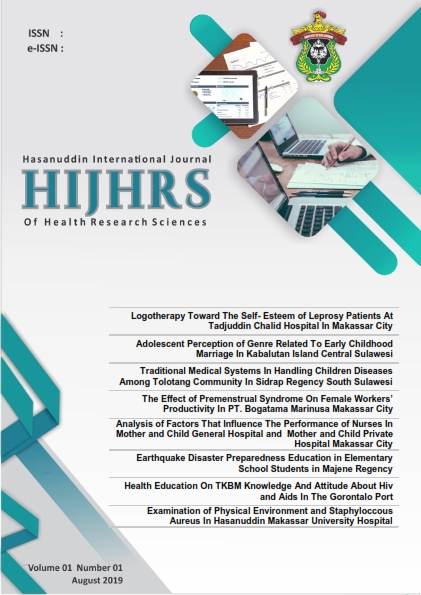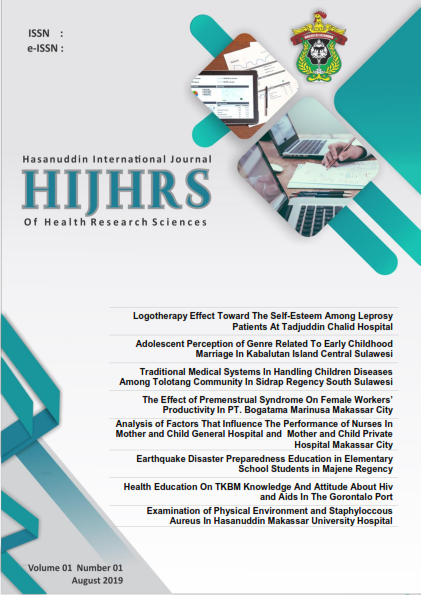Earthquake Disaster Preparedness Education in Elementary School Students in Majene Regency
Abstrak
Children are one of the vulnerable populations affected by natural disasters, due to their inability to act independently in the event of a disaster. So it takes effort to improve the preparedness of children to face natural disasters. This study aims to analyze the effect of education using simulation methods and picture book on knowledge about disaster preparedness. This research was conducted in SDN 26 Pakkola as an intervention group and SDN 28 Tamo as a control group. The method used is Quasi Experiment with the design of Non-Randomized Pre-test Post-Test Control Group Design. The total sample are 70 samples. Sampling was done in Simple Random Sampling. Data analysis using Wilcoxon Test and Mann-Whitney. The results showed that the average knowledge score experienced an increase, the intervention group (40%) while the control group (27). This study also showed differences in the average score of knowledge of respondents between the intervention and the control group. For pre-test (p = 0.962) which means there was no significant difference while in post-test 1 and 2 there are significant differences (p = 0.001 and p = 0,000). There was the effect of earthquake disaster simulation education and picture book on knowledge (p = 0,000). This study concluded that there was an effect of simulation methods and picture books on increasing student knowledge about earthquake preparedness.
Keywords: Education, Simulation, Picture Book, Preparedness, Earthquake
Referensi
Adeyemi B. & Ajibade Y. (2011). The Comparative Effects of Simulation Games and Brainstorming Instructional Strategies on Junior Secondary School Students’ Achievement in Social Studies in Nigeria. African research review. 5(3):72-73.
Bandrova T.. Savova D.. Marinova S.. Kouteva M. & Pashova L. (2015). Conceptual framework for educational disaster centre" save the children life". International Archives of the Photogrammetry. Remote Sensing & Spatial Information Sciences. 3(3):225-234.
BNPB. (2016). Risiko Bencana Indonesia. Jakarta: Badan Nasional Penanggulangan Bencana.
Enarson E.. Fothergill A. & Peek L. (2007). Gender and disaster: Foundations and directions Handbook of disaster research. New York: Springer.
Emami S.B. (2015). Pengaruh Penyuluhan Kesiapsiagaan Menghadapi Bencana Gempa Bumi terhadap Pengetahuan Siswa di SD Muhammadiyah Trisigan Murtigading Sanden Bantul (Skripsi). Yogyakarta: Sekolah Tinggi Aisyiyah.
Finnis K.K.. Johnston D.M.. Ronan K.R. & White J.D. (2010). Hazard perceptions and preparedness of Taranaki youth. Disaster Prevention and Management. An International Journal. 19(2):175-184.
Indriasari F.N. (2016). Pengaruh Pemberian Metode Simulasi Siaga Bencana Gempa Bumi terhadap
Kesiapsiagaan Anak di Yogyakarta. Jurnal Keperawatan Soedirman. 11(3):199-206.
Johnson V.A. & Ronan K.R. (2014). Classroom responses of New Zealand school teachers following the 2011 Christchurch earthquake. Natural Hazards. 72(2):1075-1092.
Johnson V.A.. Johnston D.M.. Ronan K.R. & Peace R. (2014). Evaluating children’s learning of adaptive response capacities from ShakeOut. an earthquake and tsunami drill in two Washington State school districts. Journal of Homeland Security and Emergency Management. 11(3):347-373.
Katada T. & Kanai M. (2016). The School Education to Improve the Disaster Response Capacity: A Case of “Kamaishi Miracle”. Journal of Disaster Research. 11(5):845-856.
Karanci A.N.. Aksit B. & Dirik G. (2005). Impact of a community disaster awareness training program in Turkey: Does it influence hazard-related cognitions and preparedness behaviors. Social Behavior and Personality: an international journal. 33(3):243-258.
Kementerian Kesehatan Republik Indonesia (Kemenkes RI). (2016). Kabupaten Majene termasuk daerah rawan bencana. Jakarta Selatan: Kementerian Kesehatan Republik Indonesia.
Lindell M.K.. Prater C.S.. Gregg C.E.. Apatu E.J.. Huang S.K. & Wu H.C. (2015). Households' immediate responses to the 2009 American Samoa Earthquake and Tsunami. International journal of disaster risk reduction. 12(1):328-340.
Mulilis J.P. & Duval T.S. (1997). The PrE model of coping and tornado preparedness: Moderating effects of responsibility. Journal of Applied Social Psychology. 27(19):1750-1766.
Nurgiyantoro B. (2005). Sastra Anak. Yogyakarta: UGM Press.
Olson D.K.. Scheller A.. Larson S.. Lindeke L. & Edwardson S. (2010). Using gaming simulation to evaluate bioterrorism and emergency readiness education. Public Health Reports. 125(3):468-477.
Oral M.. Yenel A.. Oral E.. Aydin N. & Tuncay T. (2015). Earthquake experience and preparedness in Turkey. Disaster Prevention and Management. 24(1):21-37.
Peek L. (2008). Children and disasters: Understanding vulnerability. developing capacities. and promoting resilience- an introduction. Children youth and environment. 18(1):1-29.
Putra H.P.A. (2014). Pelatihan mitigasi bencana kepada anak-anak usia dini. Inovasi dan kewirausahaan. 3(1):115-119.
Rahmawati A. (2016). Penerapan Sq3r Berbantunan Reka Cerita Gambar Untuk Meningkatkan Pemahaman Membaca Dan Hasil Belajar Siswa. Profesi Pendidikan Dasar. 3(2):126-132.
Rohadi S. (2009). Studi seismotektonik sebagai indikator potensi gempabumi di wilayah indonesia. Jurnal Meteorologi dan Geofisika. 10(2):111-120.
Steward D. & Wan T.T. (2007). The role of simulation and modeling in disaster management. Journal of medical systems. 31(2):125-130.
Syuaib M.Z. (2014). Pengaruh Strategi Pembelajaran Simulasi Vs Bermain Peran dan Sikap Siswa terhadap Pengetahuan dan Kesiapsiagaan tentang Bencana Alam. Jurnal Pendidikan Humaniora. 1(2):177-189.
Terpstra T. (2011). Emotions. trust. and perceived risk: Affective and cognitive routes to flood preparedness behavior. Risk Analysis: An International Journal. 31(10):1658-1675.
Rij E.V. (2016). An approach to the disaster profile of People’s Republic of China 1980-2013. Emergency and Disaster Reports. 3(4):1-48.
Winarni E.W. & Purwandari E.P. (2018). Disaster Risk Reduction for Earthquake Using Mobile Learning Application to Improve the Students Understanding in Elementary School. Mediterranean Journal of Social Sciences. 9(2):205-214.
Wu M.T.M.. Shen W.C.. Chang J.C.. Chiang Y.C.. Chen H.M. & Chen H.Y. (2013). The Impact of a Pharmacist-Conducted Interactive Anti-Smoking Education Program on the Attitudes and Knowledge of High School Students. Creative Education. 4(7):423-429
Unduhan
Diterbitkan
Terbitan
Bagian
Lisensi



